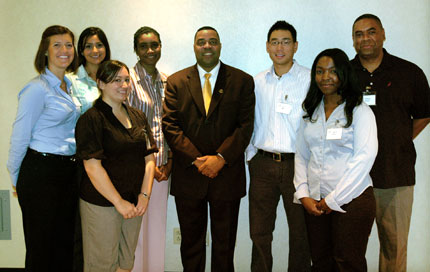Wichita State University welcomed seven residents on Aug. 3 to its inaugural Advanced Education in General Dentistry residency class. They began orientation and classes immediately and will see their first patients by Tuesday, Aug. 25.
The dentists-in-residence are chief resident Homaira Avendano, Stacey Beard and Amy Rodriguez, from the University of Illinois-Chicago; Yvette L. Chastanet, Sidney Lenox and Jeanette Young, from the Howard University College of Dentistry; and Justin Wu, from the University of Missouri-Kansas City.
Both Wu and Young have local connections already. Wu is a Wichita native; Young earned her Bachelor of Science in chemistry from WSU.
The residents will do the full spectrum of dental work at Wichita’s GraceMed Health Clinic, a community health center that is an outreach of the United Methodist Health Ministry and supported by Via Christi Health System.
The residents also will do rotations at the Dole Veterans Administration Medical Center, said Charles Fox, associate dean of the College of Health Professions.
“We are excited to begin the program with a full complement of highly qualified residents; we turned away so many who were not quite perfect matches to the program,” said Fox, who worked with Peter Cohen, dean of health professions, to create the program and search for a strong director.
Dexter Woods, director of AEGD, has done a fantastic job of recruiting, Fox said.
Woods, who earned his Doctor of Dental Surgery from Howard University, joined WSU’s College of Health Professions in 2007 to develop the program, and recruit faculty and residents. A distinguished dental educator and consultant, Woods served as director of Howard University’s AEGD program prior to coming to WSU.
Woods is also a major in the U.S. Air Force Medical Core, serving as chief of dentistry for the 459th Aerospace Medical Squadron at Andrews Air Force Base in Maryland. He is a national consultant for the Commission on Dental Accreditation, which accredits all dental and dental residency programs.
“This is exciting for Wichita State University but, more importantly, it is exciting for the state of Kansas,” said Woods. “It is our hope that this dental residency program is part of the conversation addressing access to care and increasing the number of dental health providers in the state. Ultimately, the WSU-AEGD program will provide concentrated efforts to relieve the access and work force issues plaguing rural Kansas.”
Plans for the program are to increase both the number of residents trained each year and the scope of their training, said Fox. As the only dental education program in Kansas, its purpose is two-fold: to increase access to oral health care and to create a potential pool of new dentists to help fill a statewide need.
Once the program is fully implemented, residents will be able to choose a one-year or two-year residency. The one-year residency will provide services for about 2,000 visits per resident in that year. With seven residents, that’s about 14,000 visits. A second-year residency option would place participating residents in underserved rural areas of the state.
The AEGD program will move into its own building when the capital campaign for a new facility is complete. However, it will still maintain a strong community presence through rotations at GraceMed and the VA Medical Center, and through continuing education opportunities for the Wichita dental community.
WSU is already two-thirds of the way into a $6.6 million fundraising effort for a location on north Oliver Street, just south of the Hughes Metropolitan Complex.
That includes cash, pledges and a recent grant for $476,000 secured from the federal Department of Education through a partnership with Sedgwick County, according to Lynette Murphy, the WSU Foundation director of development for the College of Health Professions.
Major donors to the campaign include Delta Dental of Kansas, Delta Dental of Kansas Foundation, W.S. and E.C. Jones Testamentary Trust, Wichita Community Foundation, Fidelity Bank, Wichita Clinic, Foulston Siefken and various individuals.
Murphy said the foundation is looking for support outside the dental and medical community, too. A nine-member volunteer campaign cabinet composed of community leaders is assisting in the fund-raising effort.
“We really are marketing this as a community program, not just a dental program,” said Murphy, “because oral health is important to overall health.”
For more information about AEGD, go to www.wichita.edu/aegd.
For information on how to contribute, go to www.wichita.edu/givetoaegd.


 Courtesy
Courtesy